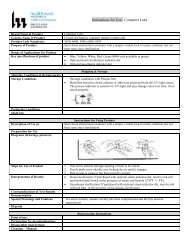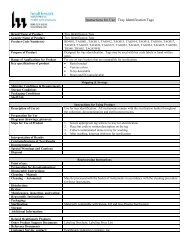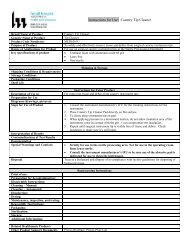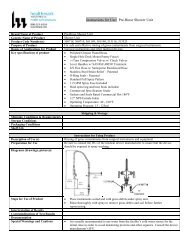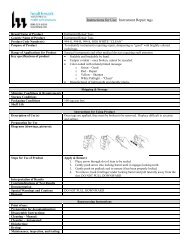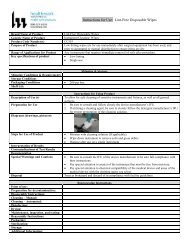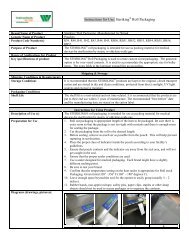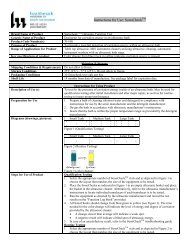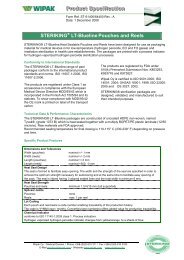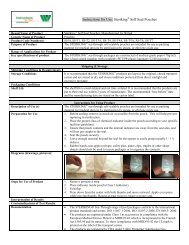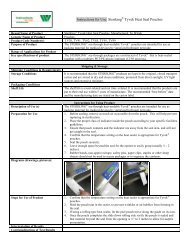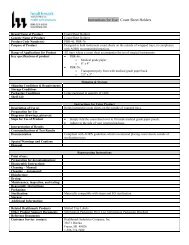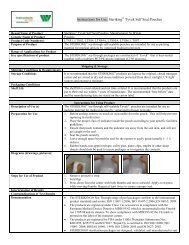Blood as a Soil on Surgical Instruments: Chemical Profile, Cleaning ...
Blood as a Soil on Surgical Instruments: Chemical Profile, Cleaning ...
Blood as a Soil on Surgical Instruments: Chemical Profile, Cleaning ...
Create successful ePaper yourself
Turn your PDF publications into a flip-book with our unique Google optimized e-Paper software.
HOME<br />
M. Pfeifer<br />
<str<strong>on</strong>g>Blood</str<strong>on</strong>g> <str<strong>on</strong>g>as</str<strong>on</strong>g> a <str<strong>on</strong>g>Soil</str<strong>on</strong>g> <strong>on</strong> <strong>Surgical</strong><br />
<strong>Instruments</strong>: <strong>Chemical</strong> <strong>Profile</strong>,<br />
<strong>Cleaning</strong>, Detecti<strong>on</strong><br />
Cl<str<strong>on</strong>g>as</str<strong>on</strong>g>sified <str<strong>on</strong>g>as</str<strong>on</strong>g> medical devices, surgical instruments require standardised and validated reprocessing. The procedure<br />
c<strong>on</strong>venti<strong>on</strong>ally employed here is cleaning and disinfecti<strong>on</strong> in a w<str<strong>on</strong>g>as</str<strong>on</strong>g>her/disinfector followed by sterilisati<strong>on</strong> in an<br />
autoclave. Since the organic c<strong>on</strong>taminati<strong>on</strong> of surgical instruments encountered in practice can be very pr<strong>on</strong>ounced,<br />
cleaning c<strong>on</strong>stitutes the b<str<strong>on</strong>g>as</str<strong>on</strong>g>is for the subsequent reprocessing steps of disinfecti<strong>on</strong> and sterilisati<strong>on</strong>. In this respect,<br />
blood represents the most comm<strong>on</strong> and hence the most important form of c<strong>on</strong>taminati<strong>on</strong>.<br />
Keywords: <str<strong>on</strong>g>Blood</str<strong>on</strong>g> coagulati<strong>on</strong>, fibrin fibres, denaturati<strong>on</strong>, residual soil, hydrolysis<br />
1 Introducti<strong>on</strong><br />
By virtue of the exceedingly complex compositi<strong>on</strong> and broad spectrum of functi<strong>on</strong>s of blood, enormous difficulties<br />
c<strong>on</strong>tinue to be faced when trying to reproduce this fluid <str<strong>on</strong>g>as</str<strong>on</strong>g> a substitute for d<strong>on</strong>or blood (1). But if <strong>on</strong>e views blood <str<strong>on</strong>g>as</str<strong>on</strong>g><br />
a cleaning problem when reprocessing surgical instruments, the majority of its biological functi<strong>on</strong>s can be disregarded.<br />
The <strong>on</strong>ly <str<strong>on</strong>g>as</str<strong>on</strong>g>pect meriting attenti<strong>on</strong> in this c<strong>on</strong>text is the process of blood coagulati<strong>on</strong> with the end product fibrin. Since,<br />
to perform their preordained t<str<strong>on</strong>g>as</str<strong>on</strong>g>ks, all blood comp<strong>on</strong>ents are necessarily present in a water-soluble form, the insoluble<br />
fibrin fibres formed during coagulati<strong>on</strong> are particularly relevant for cleaning.<br />
Of importance c<strong>on</strong>comitantly are the chemical properties of the proteins, since most of the compounds found in the<br />
blood are such proteins. Even though approx. 45% of the blood is composed of red blood cells (erythrocytes), these<br />
need not be dealt with separately because, during the cleaning process, they very e<str<strong>on</strong>g>as</str<strong>on</strong>g>ily rele<str<strong>on</strong>g>as</str<strong>on</strong>g>e through haemolysis the<br />
protein haemoglobin which accounts for up to 95% of their c<strong>on</strong>tents (2).<br />
1.1 Properties of the Proteins<br />
Proteins are generally composed of 20 different ammo acids, linked together by means of very stable peptide b<strong>on</strong>ds.<br />
Encountered here are molecular m<str<strong>on</strong>g>as</str<strong>on</strong>g>ses ranging from 10,000 to several milli<strong>on</strong>. Due to this complexity, the structure of<br />
these compounds is very complex, thus explaining the high sensitivity to chemical and even physical influences.<br />
Despite the high molecular m<str<strong>on</strong>g>as</str<strong>on</strong>g>ses, the blood proteins are water-soluble compounds. The i<strong>on</strong>izable side chains <str<strong>on</strong>g>as</str<strong>on</strong>g> well<br />
<str<strong>on</strong>g>as</str<strong>on</strong>g> the spatial arrangement (tertiary structure) of the peptide chain itself play an important role. But it is precisely the<br />
tertiary structure of the proteins that is amenable to change mediated by external influences: this process is called<br />
denaturati<strong>on</strong>.<br />
Unfolding of the polypeptide chain detracts in most c<str<strong>on</strong>g>as</str<strong>on</strong>g>es from solubility. In the c<str<strong>on</strong>g>as</str<strong>on</strong>g>e of blood proteins <strong>on</strong> a surface,<br />
this process results in hardening (coagulati<strong>on</strong>) due to the formati<strong>on</strong> of high-molecular aggregates. Temperatures<br />
between 60-70 o C suffice for complete denaturati<strong>on</strong>. An important c<strong>on</strong>siderati<strong>on</strong> here is that denaturati<strong>on</strong> is very<br />
dependent <strong>on</strong> the presence of water. For example, in a dry state c<str<strong>on</strong>g>as</str<strong>on</strong>g>ein forfeits its solubility <strong>on</strong>ly after 6 hours at 130 o<br />
C, where<str<strong>on</strong>g>as</str<strong>on</strong>g> blood immediately coagulates <strong>on</strong> immersi<strong>on</strong> in boiling water (3).<br />
Other denaturing factors are marked acidic or alkaline reacti<strong>on</strong>s of the soluti<strong>on</strong>, organic solvents. UV light and<br />
chemicals, such <str<strong>on</strong>g>as</str<strong>on</strong>g> e.g. urea or guanidine. Furthermore, aldehydes can also cause proteins to undergo direct chemical<br />
change (4). But the agent inducing the most hardening acti<strong>on</strong> is glutaraldehyde due to cross-linking of proteins (5).<br />
1.2 <str<strong>on</strong>g>Blood</str<strong>on</strong>g> Coagulati<strong>on</strong><br />
<str<strong>on</strong>g>Blood</str<strong>on</strong>g> coagulati<strong>on</strong> induces solidificati<strong>on</strong> of the liquid blood in the blood clot, thus sealing traumatised blood vessels.<br />
This ultimately entails the formati<strong>on</strong> of insoluble fibrin fibres from the soluble fibrinogen present in the blood. This
multi-step process, in which almost 20 different substances are involved, can be activated by two different pathways<br />
(6):<br />
The extrinsic pathway triggers coagulati<strong>on</strong> due to the v<str<strong>on</strong>g>as</str<strong>on</strong>g>cular injury itself. This form of activati<strong>on</strong> is effected<br />
within the space of sec<strong>on</strong>ds.<br />
The intrinsic pathway is initiated by c<strong>on</strong>tact with an unphysiological surface. This pathway is activated <strong>on</strong>ly<br />
within a few minutes.<br />
During the most important step here, thrombin cleaves two fibrin peptides from fibrinogen. Hitherto, the latter had<br />
prevented fibrinogen aggregati<strong>on</strong> thanks to their highly negative charge and due to occupati<strong>on</strong> of binding sites. The<br />
fibrin m<strong>on</strong>omers thus formed polymerise and are further stabilised by coagulati<strong>on</strong> factor XIII (cross-linking due to<br />
isopeptide b<strong>on</strong>ds). A network of fibrin fibres, enclosing the blood cells, is thus formed (6).<br />
2 Materials and Methods<br />
The soil exclusively employed for the investigati<strong>on</strong>s w<str<strong>on</strong>g>as</str<strong>on</strong>g> fresh, coagulable human blood. Dosing <strong>on</strong>ly during the first<br />
four minutes after withdrawal of the blood ensured that coagulati<strong>on</strong> would take place <strong>on</strong> the test bodies, thus making it<br />
possible to take account of the important fibrin porti<strong>on</strong>. The test bodies used were stainless-steel sheets (stainless<br />
steel material 1.4301) me<str<strong>on</strong>g>as</str<strong>on</strong>g>uring 20 x 70 mm.<br />
Since the lack of standardisati<strong>on</strong> of human blood precludes the procurement of exact reproducible findings,<br />
quantitative results were largely omitted. Hence what w<str<strong>on</strong>g>as</str<strong>on</strong>g> investigated here w<str<strong>on</strong>g>as</str<strong>on</strong>g> the chemical profile of blood in<br />
respect of cleaning and of detecti<strong>on</strong> possibilities of any residues. Quantitative investigati<strong>on</strong>s, <str<strong>on</strong>g>as</str<strong>on</strong>g> required for<br />
verificati<strong>on</strong> and optimisati<strong>on</strong> of cleaning processes, must hence be c<strong>on</strong>ducted with a standardised test soil.<br />
3 Results<br />
3.1 Solubility<br />
Figure 1 shows protein detachment (in an immersi<strong>on</strong> experiment without mechanical cleaning comp<strong>on</strong>ent) of a dried<br />
blood soil at 18 o C in demineralised water. Here it is dem<strong>on</strong>strated that after approx. 8 minutes no further reducti<strong>on</strong> is<br />
made in the remaining residue. The residual white layer is composed of insoluble fibrin fibres, which account for<br />
approx. 4% of the total protein c<strong>on</strong>tent of this blood sample. This c<strong>on</strong>firms that the red blood cells e<str<strong>on</strong>g>as</str<strong>on</strong>g>ily rele<str<strong>on</strong>g>as</str<strong>on</strong>g>e their<br />
well-soluble haemoglobin c<strong>on</strong>tent. Translated into a practical setting, this means that already pre-cleaning with clean<br />
water can remove the greatest part of c<strong>on</strong>taminati<strong>on</strong>.<br />
C<strong>on</strong>versely, a problem is caused by the fibrin fibres which cannot be dissolved even with surfactants, which, not le<str<strong>on</strong>g>as</str<strong>on</strong>g>t,<br />
becomes obvious in the fact that in the producti<strong>on</strong> of fibrin preparati<strong>on</strong>s sodium dodecyl sulphate is used for their<br />
cleaning (7). The f<str<strong>on</strong>g>as</str<strong>on</strong>g>test way to dissolve fibrin is by using an alkaline detergent at <str<strong>on</strong>g>as</str<strong>on</strong>g> high a temperature <str<strong>on</strong>g>as</str<strong>on</strong>g> possible.<br />
By means of hydrolytic cleavage of peptide b<strong>on</strong>ds this generally degrades insoluble proteins to smaller and hence more<br />
soluble products.<br />
Figure 2 shows the hydrolytic kinetics (detachment from a stainless steel surface) of fibrin, in <strong>on</strong>e instance at 100 o C<br />
in 1 molar sodium hydroxide soluti<strong>on</strong> (procedure for eluti<strong>on</strong> of residual soils) and <strong>on</strong>ce at 65 o C in 0.1 molar sodium<br />
hydroxide soluti<strong>on</strong> (similar c<strong>on</strong>diti<strong>on</strong>s <str<strong>on</strong>g>as</str<strong>on</strong>g> in automated reprocessing). In neither c<str<strong>on</strong>g>as</str<strong>on</strong>g>e are the proteins completely<br />
decomposed to amino acids. This would require at le<str<strong>on</strong>g>as</str<strong>on</strong>g>t 5 hours of heating with reflux in 5 molar sodium hydroxide<br />
soluti<strong>on</strong> (8). But the hydrolysis products of the proteins are in soluti<strong>on</strong>.<br />
3.2 Repercussi<strong>on</strong>s of Denaturati<strong>on</strong> or of <strong>Chemical</strong> Change<br />
Is h<str<strong>on</strong>g>as</str<strong>on</strong>g> already been menti<strong>on</strong>ed that heat in c<strong>on</strong>juncti<strong>on</strong> with water results in coagulati<strong>on</strong> of blood proteins. Figure 3<br />
illustrates the quantity of blood protein remaining <strong>on</strong> the stainless-steel surfaces after a 10-minute immersi<strong>on</strong> in<br />
demineralised water at 50-80 o C. Noticeable here is that even at 80 o C. approx. <strong>on</strong>e third of the proteins are detached<br />
from the surface. The remaining residues, however, were in all c<str<strong>on</strong>g>as</str<strong>on</strong>g>es hardened due to coagulati<strong>on</strong> and evidence<br />
incre<str<strong>on</strong>g>as</str<strong>on</strong>g>ed adhesi<strong>on</strong> to the surface. Hence, in automated reprocessing the temperature employed for pre-cleaning should<br />
never exceed 40 o C.<br />
In a dry state proteins are largely insensitive to thermal denaturati<strong>on</strong>. Accordingly, dried blood can be e<str<strong>on</strong>g>as</str<strong>on</strong>g>ily heated for<br />
o
10 minutes up to 100 C, without the proteins forfeiting their water solubility. Much more resistant soils are obtained<br />
due to the effects of aldehydes c<strong>on</strong>tained in disinfectants, which e<str<strong>on</strong>g>as</str<strong>on</strong>g>ily react with the amino groups of the proteins (9).<br />
Glutaraldehyde hardens blood proteins so much that, during hydrolysis at 65 o C in 0.1 molar sodium hydroxide<br />
soluti<strong>on</strong>, even after two hours no soluti<strong>on</strong> can be observed. The eluti<strong>on</strong> procedure (In NaOH/100 o C/lh) used here for<br />
determinati<strong>on</strong> of residual proteins leads, depending <strong>on</strong> the layer thickness, to quantitative eluti<strong>on</strong> <strong>on</strong>ly after approx. 50<br />
minutes. C<strong>on</strong>versely, iodine-and alcohol-b<str<strong>on</strong>g>as</str<strong>on</strong>g>ed disinfectants generate <strong>on</strong>ly a slight change, which does not essentially<br />
hamper reprocessing with alkaline detergents.<br />
3.3 Detecti<strong>on</strong> Methods<br />
Myriad detecti<strong>on</strong> methods are described in the literature (10). In all these determinati<strong>on</strong> methods it is, however,<br />
essential to quantitatively bring the residual soil to soluti<strong>on</strong>. Since in the c<str<strong>on</strong>g>as</str<strong>on</strong>g>e of a residual soil in w<str<strong>on</strong>g>as</str<strong>on</strong>g>her/disinfectors,<br />
water-soluble, surfactant-soluble and e<str<strong>on</strong>g>as</str<strong>on</strong>g>ily hydrolysed proteins have been removed and the remaining proteins have<br />
been hardened due to the thermal final disinfecti<strong>on</strong> and heat denaturati<strong>on</strong>, simple eluti<strong>on</strong>, for example with a surfactant<br />
soluti<strong>on</strong> or with a sodium hydroxide at room temperature, does not suffice. Moreover, methods used to determine the<br />
free amino groups of proteins are too imprecise, since for example after chemical changes induced by aldehydes, no<br />
amino groups can be detected any more. C<strong>on</strong>comitantly, the number of free amino groups changes depending <strong>on</strong> the<br />
hydrolytic cleavage of a protein.<br />
UV absorpti<strong>on</strong> h<str<strong>on</strong>g>as</str<strong>on</strong>g> proved to the method of choice, which is b<str<strong>on</strong>g>as</str<strong>on</strong>g>ed <strong>on</strong> the light absorpti<strong>on</strong> of aromatic amino acids.<br />
This method h<str<strong>on</strong>g>as</str<strong>on</strong>g> the advantage of enabling hydrolysis to be employed <str<strong>on</strong>g>as</str<strong>on</strong>g> an eluti<strong>on</strong> method, since absorpti<strong>on</strong> at 240<br />
nm is not dependent <strong>on</strong> the degree of hydrolysis. Accordingly fibrin fibres, denatured proteins and even proteins that<br />
have been cross-linked by glutaraldehyde can be quantitatively acquisiti<strong>on</strong>ed. In additi<strong>on</strong>, haemoglobin <str<strong>on</strong>g>as</str<strong>on</strong>g> the chief<br />
c<strong>on</strong>stituent of the blood can be separately acquisiti<strong>on</strong>ed due to the maximum absorpti<strong>on</strong> of its hydrolysis products<br />
which is 388 nm.<br />
Residual proteins can also be well recognised visually. As illustrated in figure 4, even 0.001 mg (lug) of haemoglobin<br />
can be e<str<strong>on</strong>g>as</str<strong>on</strong>g>ily seen <strong>on</strong> a stainless-steel surface. The haemoglobin had been distributed by dosing aliquots of 10 ul of a<br />
corresp<strong>on</strong>ding standard soluti<strong>on</strong>, and thus takes up a surface of approx. 15 mm 2 . Of course, visual inspecti<strong>on</strong> does not<br />
permit either quantitative or qualitative cl<str<strong>on</strong>g>as</str<strong>on</strong>g>sificati<strong>on</strong> of a residual soil.<br />
4 Discussi<strong>on</strong><br />
The experiments c<strong>on</strong>ducted here give an insight into the manifold investigati<strong>on</strong> methods, attributable to the ultra<br />
complexity of the chemistry of the proteins. For example, denaturati<strong>on</strong> is also largely a functi<strong>on</strong> of the pH value, while<br />
in practice various pH values can be encountered due to neutral, alkaline and acidic detergents. More thorough,<br />
quantitative investigati<strong>on</strong>s should be c<strong>on</strong>ducted in all these domains, using a standardised test soil, since <strong>on</strong>ly in this<br />
manner exact, reproducible and comparable results can be obtained.<br />
It h<str<strong>on</strong>g>as</str<strong>on</strong>g> been c<strong>on</strong>comitantly revealed that eluti<strong>on</strong> with sodium dodecyl sulphate (SDS) does not suffice for quantitative<br />
determinati<strong>on</strong> of residual proteins in prac-tice. C<strong>on</strong>versely, in laboratory experiments a high recovery rate can be<br />
obtained by mechanical fragmentati<strong>on</strong> of test bodies. Determinati<strong>on</strong> of free amino groups with o-phtaldialdehyde<br />
(OPA) also entails problems, since their number in the c<str<strong>on</strong>g>as</str<strong>on</strong>g>e of chemically transformed and partially hydrolysed<br />
proteins is no l<strong>on</strong>ger proporti<strong>on</strong>al to the b<str<strong>on</strong>g>as</str<strong>on</strong>g>eline protein quantity. Using hydrolysis and me<str<strong>on</strong>g>as</str<strong>on</strong>g>urement of the UV<br />
absorpti<strong>on</strong>, residual proteins can, c<strong>on</strong>versely, be reliably and quantitatively acquisiti<strong>on</strong>ed.<br />
References/Literatur<br />
1. Spektrum der Wissenschaft 1998 (4): 56-61.<br />
2. Mutschler E: Arzneimitteiwirkunyen, Lehrbuch der Pharniakoloigie und Toxikologie, 6.. vollig neu bearbeitete und<br />
erweiterte Auflaye: 353-354.<br />
3. Joly M: A Physio-chemical Approach to the Denaturati<strong>on</strong> of Proteins 1965: 162.<br />
4. Fraenkel-C<strong>on</strong>ratu H. Oclott HS: J. Amer. Chem. Soc. 1948:70:2673.<br />
5. Rompp Chemie Lexik<strong>on</strong>, 9.. erweiterte und neubearbeitete Auflaye: 1607.<br />
6. Voet D. Voet JG: Biochemie. 1 Korr. Nachdruck, 1994:1100-1109.<br />
7. Duhamel RC. Meezan E. Brendel K: A simple procedure for the purificati<strong>on</strong> of bovine fibrin from clottet blood by
the use of detergents. Prep. Biochem. 1980; 10 (1):43-58.<br />
8. Neurath H: The Proteins. Compositi<strong>on</strong>. Structure and Funkti<strong>on</strong>. Sec<strong>on</strong>d Editi<strong>on</strong>. Volume 1: 35.<br />
9. Fraenkel-C<strong>on</strong>ratu H. Oclott HS: J. Amer. Chem. Soc. 1948:70: 2673.<br />
10. Rompp Chemie Lexik<strong>on</strong>. 9., erweiterte und neubearbeitete Auflage: 3655.<br />
HOME



